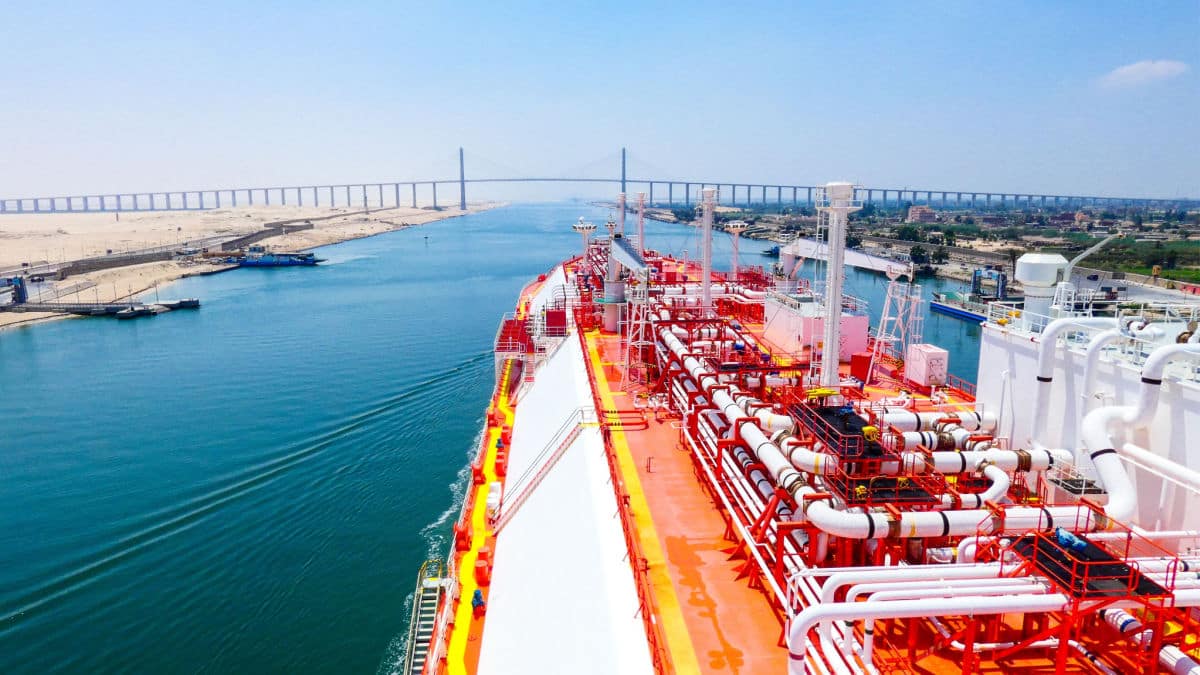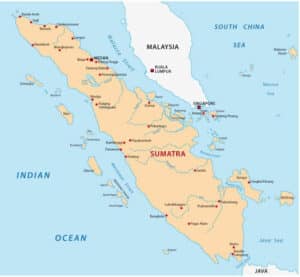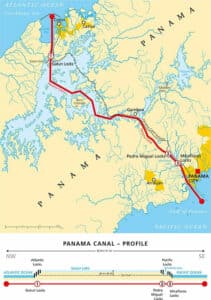US and China on collision course over sea trade routes
Differing security approaches amid tumultuous world events increases the risk of escalation and further disruption to trade around maritime chokepoints

Shortages of hydrocarbons and food staples around the world have highlighted the importance of the global trading order, and its vulnerability to disruption.
Consequently, the security of international maritime routes, – particularly chokepoints at high risk of politicisation and physical disruption – is a top priority on national security agendas.
This is particularly true of the US and China. Each seeks to ensure its control over the waterways vital to its economic stability and development, and geopolitical ambitions.
For now, a fragile balance exists whereby both pursue stability of key shipping routes through the lens of national security interests.
But the repercussions of the global pandemic and Russia’s invasion of Ukraine – slowed economic growth, competition over access to commodities, high inflation and the fragility of global supply chains – are pushing Beijing and Washington closer towards a tipping point. Each is currently testing the other’s tolerance threshold, and a fundamental shift in the global balance of power is looming.
Diverging approaches to national security: the US vs China
Washington and Beijing share a common interest in securing the continued flow of goods to and from their markets. But their respective approaches are very different, in line with their national priorities, the perceived threats to these priorities and styles of strategic engagement.
Beijing views China’s security as intrinsically linked to its economic growth, which is dependent on trade with international markets via global maritime chokepoints. It sees these as vulnerable to US influence, thereby threatening the security of China itself. As a result, it has sought to reduce its reliance on the Western economic system and its dependence on vulnerable maritime sea routes by creating an independent trade order through its fully state-funded Belt and Road Initiative (BRI).
Launched in 2013, the BRI is engaged in constructing two new trading routes – overland and maritime – connecting China to the rest of the world. Its aims are twofold: to create economic interdependence with participating countries, and to provide an expanded international market for Chinese goods and opportunities for Chinese businesses. In so doing, it seeks to secure both China’s economic growth and its position as a major global power.
This policy is conducted in a carefully constructed, layered approach: China provides loans to countries in proximity, or with direct access, to key maritime chokepoints for the development of critical infrastructure in sectors such as manufacturing, transport and energy. Chinese systems and products are integrated into trading and shipping infrastructure, and private sector or state-owned entities engaged in construction or operation are used to collect commercially and strategically sensitive information pertinent to China’s interests.
This primes the ground for the next stage of engagement with participating countries: closer diplomatic ties built on economic dependency, followed by military or defence industry collaboration. The original commercial entities often – surprisingly or not – become dual purpose, able to meet security objectives.
By extending its reach into the economic heart of countries along key shipping routes, China is playing a slow but strategic game of securing its interests across all three portfolios: economic, political and defence. Its approach has the potential to clash with Washington’s own national security policy, which seeks to contain the influence of actors that it believes threaten the existing global order and the US’s dominant role within it – be that China, Russia, Iran or any other.
The US will not intentionally engage in conflict, unless provoked, but it will take measures of deterrence to maintain the status quo.
Chokepoints: potential flashpoints in US-China relations
Competition for resources and control over access to them is a top priority for President Xi, given China’s expected return to economic growth post-pandemic; its increasing reliance on imports of foreign oil and gas to fuel its industry-led economy and growing population; and the measures being taken by western allies to sanction Russian supplies.
However, China’s investments in and around globally significant shipping routes – particularly critical maritime chokepoints – are increasingly a concern to Washington.
It is in the interests of both states to keep the international waterways safe and open for trade; however, their differing approaches have set the two states on a collision course in the following areas: the Middle East’s Strait of Hormuz, Bab el-Mandeb Strait and the Suez Canal; Asia’s Strait of Malacca; and the soon-to-open Arctic routes: the Northern Sea Route and Canadian Northwest Passage, to which the Bering Strait is critical.
The following section describes the importance of these chokepoints to global trade, and assesses the balance of US-China interests, and the potential for escalation and disruption.
The Middle East:
Suez Canal and Bab el Mandeb Strait
- Connects the Mediterranean to the Arabian Sea.
- Together carried 1.32bn tonnes of cargo in 2021–22, including 7%-10% of world’s crude, and 8% of its LNG transfers.
- Over 60% of Chinese goods shipped to Europe transit the Suez Canal.
Strait of Hormuz
- Only sea passage connecting Arabian Gulf to open ocean; located to east of Saudi Arabia.
- Vital route for major oil producers exporting hydrocarbons to Asian market.
- Carries approx. 20% global oil trade.
- 5m barrels per day (26% of total bpd) go to China. In total, carries approx. 38% of China’s total annual oil imports.
The Red Sea’s Suez Canal and the Bab el Mandeb Strait are key strategic nodes in China’s Maritime Silk Road component of the BRI. China is the largest investor in Egypt’s Suez Canal Corridor, viewing the North African state as a regional manufacturing hub for Chinese businesses, given that the canal is the Asian giant’s main shipping route to its largest market: Europe.
Suez’s vulnerability to disruption – and the global consequences of such disruption – was highlighted in 2020 when the VLCC Ever Given blocked the canal for six days, preventing the passage of $10bn of daily trade.
Meanwhile, the Bab el Mandab Strait is one of the world’s most critical chokepoints for oil flows. Bordering Yemen, it is vulnerable to overspill from the country’s ongoing conflict.
Hormuz is also a prime target for disruptive activities, mostly directed by the Iranian regime in pursuit of twin goals: to upset the interests of Riyadh and Abu Dhabi – which export the majority of their hydrocarbons through this route – and to jeopardise the international oil markets and shipping in response to ideological differences with, and sanctions imposed against Iran by, Western powers.
As a result, the Hormuz Strait’s security has historically been a primary focus point in US Middle East policy.
The balance of interests
In order to prioritise its interests in the Asia Pacific, Washington is seeking to reduce the US’s operational presence, and its responsibility for security, in the Middle East.
As such, its role in assuring the physical security of the region’s waterways is set to change. Rather than act as security guarantor, it is pursuing a burden-sharing approach with Middle East capitals. However, this is a long-term project with a 20-year time horizon. This means the US will continue to keep a watchful eye over key shipping routes, given their importance to global commodities supplies – and by extension, prices.
The Middle East chokepoints will remain of strategic importance to Washington for other reasons, too. China has sought to minimise antagonism with the US in this region, content to allow Washington to lead on security provision while benefitting from the status quo without having to commit its own resources. But as tensions rise, it has begun to militarise its approach.
It has boosted defence cooperation with Cairo, and further south it has established a military base in Djibouti – its first permanent overseas military presence. It also plans to construct other defence facilities – or sites with the ability to become dual purpose.
Through these actions, Beijing is hedging against a possible attempt by the US to restrict or curtail energy flows to China in a future conflict or crisis scenario.
Beijing has also refused invitations for China to participate in naval patrols to ensure the security of shipping vessels passing through the chokepoints. Instead, it has deliberately maintained relations with both Iran and Saudi Arabia – conducting naval training exercises with each – to ensure smooth passage of commodities to Chinese markets.
Approximately 38% of China’s total annual oil imports transit through Hormuz. Its 2020 announcement of a $400bn investment package for Iran’s oil and gas sector is undoubtedly an insurance policy against disruption to its interests in these waters.
South-east Asia:
Malacca Strait
- Connects South China Sea to Andaman Sea, and Pacific and Indian Oceans.
- Located between Sumatra, Indonesia and Malay Peninsula.
- One of world’s narrowest straits: 1.5 nautical miles at narrowest point.
- Accounts for over 40% of global trade.
Moving eastwards, the Malacca Strait is a natural strategic chokepoint. It is one of the narrowest stretches of water in the world, making it a perilous place for ships. Singapore, a major US ally that frequently participates in US naval drills, is located at the mouth of the strait’s eastern opening.
The strait is one of the busiest shipping routes in the world: over 100,000 vessels pass through it every year.
It is also geopolitically important to Asia, and China in particular, as 70-85% of the country’s imported oil transits the strait after passing through the Hormuz chokepoint on its way from the Middle East. Former President Hu Jintao encapsulated the country’s vulnerability to the key waterway when he characterised China’s oil dependency as the “Malacca Dilemma.”
The balance of interests
China became the world’s largest oil importer in 2017, surpassing the US. The US Department of Commerce expects that by 2040, China will be dependent on imports for 80% of its oil requirements. Should the Malacca Strait be closed, the Lombok and Makassar Straits offer alternative passages; however, they are much longer routes and would incur additional shipping costs estimated to be from around $84bn to $220bn per year, according to the S. Rajaratnam School of International Studies.
Washington, meanwhile, views the strait as an essential channel for transporting its exports to Asia Pacific markets and ensuring the economic wellbeing of its allies. South Korea and Japan are dependent upon the strait for the free flow of oil, LNG and commodities. The commercial reasons for preserving a balance of interests in the Malacca Strait are compelling.
However, the strait’s proximity to the South China Sea, a flashpoint in US-China relations, makes this vital sea route particularly vulnerable to disruption.
Washington has made long-standing security guarantee commitments to its allies in the region, including Taiwan, and it has committed to supporting them in resisting Chinese territorial claims in the South China Sea. The Malacca Strait’s strategic importance partly explains the continued presence of the US Seventh Fleet – its largest forward-deployed fleet – in Yokosuka, Japan.
Therefore, tensions in the South China Sea are prone to rise and fall, as they correlate to fissures in US-Chinese relations.
For example, Russia’s invasion of Ukraine in February 2022 has been a cause for concern for Washington, and for Taiwan and other US ally states. In response to Beijing’s support for Russia, the US sent the House Speaker Nancy Pelosi to Taipei in August 2022 with an unequivocal message of support.
As an exercise of its deep displeasure at the move, China held joint military exercises around Taiwan, launched ballistic missiles over the island, and conducted air and naval operations across the centreline and on the edge of Taiwan’s territorial waters. It also suspended or cancelled eight official military dialogues and cooperation channels with the US.
However, it is highly unlikely that the Malacca Strait will close due to political or military actions. Political tensions between Washington and Beijing will ebb and flow over the coming decades, especially as the balance of power between the two large countries edges towards equilibrium. But as long as their commercial interests continue to overlap, and that looks likely even in the event that they begin to regionalise production, then the strait will remain a secure waterway. The main hazards are, and will continue to be, piracy, environmental degradation, congestion and haze.
Latin America:
Panama Canal
- Accounts for 6% global trade, majority carried out with US.
- 22% of cargoes start/finish in China.
- Logistical hub for Chinese products entering Latin America.
The Panama Canal’s significance to the US is growing due to Washington’s increased focus on regionalisation, or “near-shoring”, to mitigate against risks associated with long supply chains and distant markets highlighted by the global pandemic.
The canal is also not immune to Chinese influence. Panama was the first Latin American country to sign on to the BRI initiative, in 2017, and with port contracts at either end of the channel along with multiple investments in the logistics, infrastructure and power sectors, China’s presence in, and influence over, this arena has been rising steadily.
The balance of interests
Tensions over Beijing’s more strident posture on both Hong Kong and Taiwan, and its activities on the US’s doorstep in South America – in Venezuela and Chile – have, in Washington’s view, increased the risk of disruption to the canal’s trade, and therefore US economic security.
Pushback in recent times from both Washington and the current Panamanian administration has somewhat stalled China’s ambition, a signal that the Central American country is conscious of the need to placate both great powers despite, or perhaps because of its neutral status and commitment to grant equal access to all nations.
It was this same position that saw Panama resist calls to block the passage of Russian ships following Moscow’s invasion of Ukraine in February 2022. But the US has reserved the right to intervene militarily to combat any perceived threat to the canal’s neutrality, and in the current climate, China will need to tread carefully to avoid this.
The Arctic:
Arctic and Bering Straits
As global warming melts sea ice, the Arctic is gradually opening up and along with it, the possibility of new sea routes that could reduce shipping times by up to two weeks. However, these channels face a similar fate to other key seaborne trade routes, namely competition borne out of geopolitical rivalry.
The Balance of interests
While littoral states – the US, Canada, Norway, Russia and Greenland – accept that the Law of the Sea Convention is the most appropriate legal framework through which to govern the Arctic region, differences over interpretation remain, specifically regarding what areas might fall under national as opposed to international jurisdiction.
Against this backdrop, tensions with Russia and increased competition to secure access to energy resources look set to continue, meaning operationalising these routes will be challenging. As with other maritime chokepoints, the Bering Strait – as the sole sea line of communication between the Pacific and Arctic oceans – will become hotly contested.
China has already expressed its desire for uninhibited passage through the Arctic routes, but as an observer to the Arctic Council – the primary leadership body for the region – it will need to secure support from the council’s other members.
Its key ally Russia is also on the outside as the only non-NATO member of the council. But even the relationship between Moscow and Beijing may not be enough for Russia to back China’s interests in this space. Logistical challenges aside, the Arctic routes are a tempting alternative to long and costly shipping routes. But for that very reason, they too will be subject to competition and global geopolitical machinations.
Growing rivalry heightens risk of escalation
As the competition between China and the US edges the global order towards fragmentation, the importance of maritime chokepoints to national security strategies will only grow.
At present, each is gently testing the other’s appetite for risk and escalation while pursuing its own interests. But as history has demonstrated, slow-burning embers can erupt into wildfire with just one spark. The significance of international waterways – and the battle to control them – may be the match.






